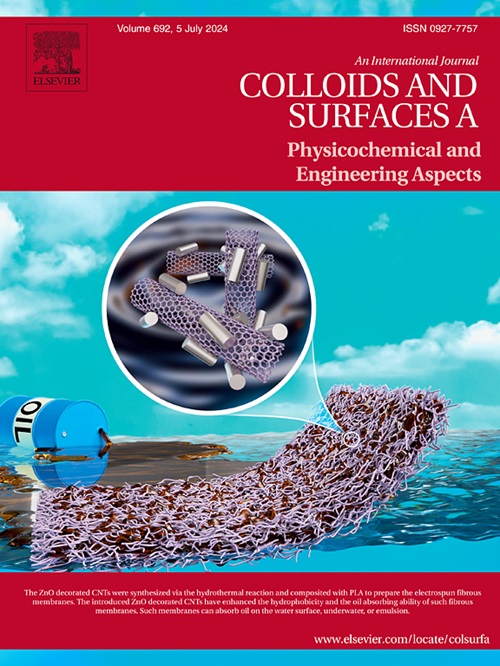具有三维微结构的混合硅酸盐可加速伤口愈合中的抗菌止血效果
IF 4.9
2区 化学
Q2 CHEMISTRY, PHYSICAL
Colloids and Surfaces A: Physicochemical and Engineering Aspects
Pub Date : 2024-10-28
DOI:10.1016/j.colsurfa.2024.135644
引用次数: 0
摘要
具有抗菌止血效果的硅酸盐可用于伤口愈合,作为传统生物医药的抗生素替代品。含有两种或两种以上不同形态的硅酸盐的混合硅酸盐具有更快的抗菌止血效果(例如:高岭石-蒙脱石-高岭土)、高岭石-蒙脱石对大肠杆菌和金黄色葡萄球菌的抗菌率最高可达 59.14 ± 1.46 % 和 91.83 ± 0.85 %,对高岭石-蒙脱石的凝血指数和止血时间最高可达 4.06 ± 1.56 % 和 165.67 ± 6.13 s),这可能是由于混合硅酸盐中单个硅酸盐的表面/边缘电荷和单个硅酸盐松散堆积状态所构建的三维微观结构特征所产生的单个硅酸盐固有的抗菌止血效果。此外,抗菌止血效果不佳的原因还在于硅酸盐质量比不合理导致的三维微结构构建不成功。目前的研究结果表明,考虑到生物医学功能模块的搭配和实际场景的定位,具有加速抗菌止血效果的混合硅酸盐可用于伤口愈合。本文章由计算机程序翻译,如有差异,请以英文原文为准。
Mixed silicates with three-dimensional micro-architecture toward accelerate the antibacterial hemostatic effects in wound healing
Silicates with the antibacterial hemostatic effects used in wound healing that could be served as antibiotic alternatives to traditional biomedicines. Mixed silicates containing two or more silicates with different morphologies exhibit an accelerated antibacterial hemostatic effects (e.g., the antibacterial rate toward kaolinite-montmorillonite against E. coli and S. aureus reached a maximum value of 59.14 ± 1.46 % and 91.83 ± 0.85 %, the blood clotting index and the hemostatic time toward kaolinite-montmorillonite reached a maximum value of 4.06 ± 1.56 % and 165.67 ± 6.13 s), that could be attributed to the individual silicate’s intrinsic antibacterial hemostatic effects arising from the silicate’s surface/edge charge and the constructed three-dimensional micro-architectural characteristics arising from the individual silicate’s loose stack state in mixed silicates. Besides, those ineffective antibacterial hemostatic effects were attributed to the unsuccessful three-dimensional micro-architectural construction originated from the silicate’s unreasonable mass ratio. The current findings illustrated that mixed silicates with an accelerated antibacterial hemostatic effects could be used in wound healing with taking into account biomedical functional module collocation and actual scenario orientation.
求助全文
通过发布文献求助,成功后即可免费获取论文全文。
去求助
来源期刊
CiteScore
8.70
自引率
9.60%
发文量
2421
审稿时长
56 days
期刊介绍:
Colloids and Surfaces A: Physicochemical and Engineering Aspects is an international journal devoted to the science underlying applications of colloids and interfacial phenomena.
The journal aims at publishing high quality research papers featuring new materials or new insights into the role of colloid and interface science in (for example) food, energy, minerals processing, pharmaceuticals or the environment.

 求助内容:
求助内容: 应助结果提醒方式:
应助结果提醒方式:


